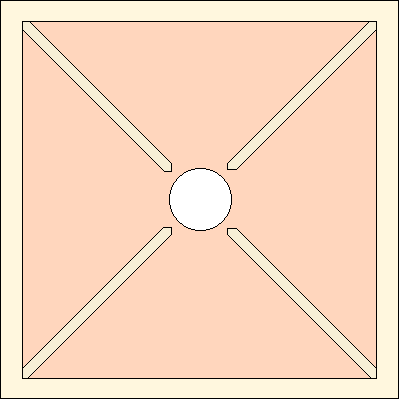Formerly titled:- 'Experiment... Bees will follow an edge'

The drawing shown right (or one very much like it) appeared in a magazine (A5 size, British, about 1980, printed on glossy paper) it illustrated a method of increasing the speed of operation of a Porter escape board.
The modification consisted simply of fitting two triangles of 6 mm plywood on to the upper surface of an existing porter escape board.
The test that I conducted was slightly different... It used an
Eight Way Escape Board.
Four pieces of ramin 7 mm square were fixed in the positions shown in the drawing below, using "double sided" adhesive tape.
There was no significance in my choice of 7 mm ramin strips... There just happened to be several lengths of this material leaning up against the wall in one corner of the workshop.

The testing was done using a 75 mm eke that had two adjacent sides made of perspex (plexiglass?) which was put in place between the super to be cleared and the escape board which was on the top of the brood chamber. One of the solid sides was towards the sun so that direct sunlight did not shine into the space being observed.
There may have been a "Herzog" framed wire queen excluder between the top of the brood box and the bottom of the escape board, but I cannot remember whether or not this was the case.
The escape board used had a 63 mm lower rim and a 9 mm upper rim.
Observations
Some bees ran about on the inside of the perspex panels.
Those bees that "bumped into" the ramin strips mostly turned right or left and followed the "edge". I judged (not counted) that 10% of the bees walked over the strips. Of those bees that hit the strips near to the centre hole more turned towards the centre hole than away from it. Those bees that hit the strips near the outer end about half turned left and half turned right. The density of bees alongside the ramin strips was greater than in the open spaces. The activity in the open spaces was not totally random... There was a bias towards the central hole.
This page has been written from memory, (memory is not perfect after 20 years) but the original test described and my version of it are both very simple to duplicate. I would be pleased to hear from anyone that cares to run the tests for themselves.
Dave Cushman.

